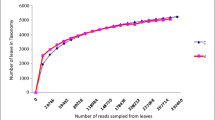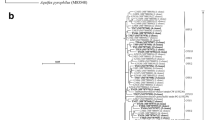Abstract
The water buffalo (Bubalus bubalis) is a prominent livestock species for the production of milk and meat in many countries. We investigated the diversity of rumen methanogens in Mediterranean water buffaloes maintained in Brazil under different diets: corn silage, grazing pasture, or sugar cane. A total of 467 clones were isolated from three methanogen 16S rRNA gene clone libraries that each represented a distinct feed type. The 467 clones were assigned to 19 species-level operational taxonomic units (OTUs). Four OTUs were represented in all three libraries, eight OTUs were library-specific, six OTUs were found in only the corn silage and pasture grazing libraries, and one OTU was shared only between pasture grazing and sugar cane libraries. We found that Methanobrevibacter-related sequences were the most abundant in the water buffaloes sampled for our analysis, in contrast to previously reported studies showing that Methanomicrobium mobile-like methanogens were the most abundant methanogens in water buffaloes of Murrah and Surti breeds sampled in India. Considering the worldwide distribution of water buffaloes and the likely wide variety of diets provided, our results combined with studies from other groups support that larger scope analyses of microbiomes for this livestock species would provide great insight into the contribution of geographical location, breed, and diet in determining the population structure of rumen microorganisms.



Similar content being viewed by others
References
Altschul SF, Madden TL, Schäffer AA, Zhang J, Zhang Z, Miller W, Lipman DJ (1997) Gapped BLAST and PSI-BLAST: a new generation of protein database search programs. Nucleic Acids Res 25:3389–3402
An D, Dong X, Dong Z (2005) Prokaryote diversity in the rumen of yak (Bos grunniens) and Jinnan cattle (Bos taurus) estimated by 16S rDNA homology analyses. Anaerobe 11:207–215
Chaudhary PP, Sirohi SK (2009) Dominance of Methanomicrobium phylotype in methanogen population present in Murrah buffaloes (Bubalus bubalis). Lett Appl Microbiol 49:274–277
Evans PN, Hinds LA, Sly LI, McSweeney CS, Morrison M, Wright A-DG (2009) Community composition and density of methanogens in the foregut of the Tammar wallaby (Macropus eugenii). Appl Environ Microbiol 75:2598–2602
FAO (2000) Water buffalo: an asset undervalued. FAO Regional Office for Asia and Pacific, Bangkok, pp 1–6
Felsenstein J (2006) PHYLIP (Phylogeny Inference Package) documentation files, version 3.66. Department of Genome Sciences, University of Washington, Seattle
Giordano G, Guarini P, Ferrari P, Biondi-Zoccai G, Schiavone B, Giordano A (2010) Beneficial impact on cardiovascular risk profile of water buffalo meat consumption. Eur J Clin Nutr 64:1000–1006
Good IJ (1953) The population frequency of species and the estimation of population parameters. Biometrika 40:237–262
Hook SE, Wright A-DG, McBride BW (2010) Methanogens: methane producers of the rumen and mitigation strategies. Archaea 2010:1–11
Hook SE, Steele MA, Northwood KS, Wright A-DG, McBride BW (2011) Impact of high-concentrate feeding and low ruminal pH on methanogens and protozoa in the rumen of dairy cows. Microb Ecol 62:94–105
Iqbal A, Khan BB, Riaz M (2009) Water buffalo: some socio-economic and welfare aspects—a review. Pakistan J Zool Suppl Ser 9:503–509
Kim M, Morrison M, Yu Z (2011) Status of the phylogenetic diversity census of ruminal microbiomes. FEMS Microbiol Ecol 76:49–63
Kimura M (1980) A simple method for estimating evolutionary rates of base substitutions through comparative studies of nucleotide sequences. J Mol Evol 16:111–120
Michelizzi VN, Dodson MV, Pan Z, Amaral MEJ, Michal JJ, McLean DJ, Womack JE, Jiang Z (2010) Water buffalo genome science comes of age. Int J Biol Sci 6:333–349
Nanda AS, Nakao T (2003) Role of buffalo in the socioeconomic development of rural Asia: current status and future prospects. Anim Sci J 74:443–455
NRC (1981) The water buffalo: new prospects for an underutilized animal. National Academy Press, Washington, DC
Pradhan K, Bhatia SK, Sangwan DC (1991) Relative rumen ecosystem and nutrient digestibility in cattle and buffalo fed high fibrous diets. Haryana Agricultural University, Hisar
Saitou N, Nei M (1987) The neighbor-joining method: a new method for reconstructing phylogenetic trees. Mol Biol Evol 4:406–425
Schloss PD, Westcott SL, Ryabin T, Hall JR, Hartmann M, Hollister EB, Lesniewski RA, Oakley BB, Parks DH, Robinson CJ et al (2009) Introducing mothur: open-source, platform-independent, community-supported software for describing and comparing microbial communities. Appl Environ Microbiol 75:7537–7541
Singh KM, Tripathi AK, Pandya PR, Parnerkar S, Rank DN, Kothari RK, Joshi CG (2011) Methanogen diversity in the rumen of Indian Surti buffalo (Bubalus bubalis), assessed by 16S rDNA analysis. Res Vet Sci. doi:10.1016/j.rvsc.2011.1003.1022
St-Pierre B, Wright A-DG (2012) Molecular analysis of methanogenic archaea in the forestomach of the alpaca (Vicugna pacos). BMC Microbiol 12:1
Sundset MA, Edwards JE, Cheng YF, Senosiain RS, Fraile MN, Northwood KS, Præsteng KE, Glad T, Mathiesen SD, Wright A-DG (2009) Rumen microbial diversity in Svalbard reindeer, with particular emphasis on methanogenic archaea. FEMS Microbiol Ecol 70:553–562
Sundset MA, Edwards JE, Cheng YF, Senosiain RS, Fraile MN, Northwood KS, Præsteng KE, Glad T, Mathiesen SD, Wright A-DG (2009) Molecular diversity of the rumen microbiome of Norwegian reindeer on natural summer pasture. Microb Ecol 57:335–348
Thauer RK, Kaster AK, Seedorf H, Buckel W, Hedderich R (2008) Methanogenic archaea: ecologically relevant differences in energy conservation. Nat Rev Microbiol 6:579–591
Thorpe A (2008) Enteric fermentation and ruminant eructation: the role (and control?) of methane in the climate change debate. Clim Chang 93:407–431
Wanapat M, Pilajun R, Kongmun P (2009) Ruminal ecology of swamp buffalo is influenced by dietary sources. Ani Feed Sci Tech 151:205–214
Wanapat M, Sommart K, Wachirapakorn C, Uriyapongson S, Wattanachant C (1994) Recent advances in swamp buffalo nutrition and feeding. In: Wanapat M, Sommart K (eds) Proc. the 1st Asian Buffalo Association Congress. Khon Kaen University, Khon Kaen
Whitford MF, Teather RM, Forster RJ (2001) Phylogenetic analysis of methanogens from the bovine rumen. BMC Microbiol 1:1–5
Wolin MJ (1979) The rumen fermentation: a model for microbial interactions in anaerobic ecosystems. In: Alexander M (ed) Advances in microbial ecology, vol. 3. Planum Press, New York, pp 49–77
Wolin MJ (1982) Hydrogen transfer in microbial communities. In: Bull AT, Slater JH (eds) Microbial interactions and communities, vol. 1. Academic, London, pp 323–356
Wright A-DG, Pimm C (2003) Improved strategy for presumptive identification of methanogens using 16S riboprinting. J Microbiol Methods 55:337–349
Wright A-DG, Dehority BA, Lynn DH (1997) Phylogeny of the rumen ciliates Entodinium, Epidininum and Polyplastron (Litostomatea: Entodiniomorphida) inferred from small subunit ribosomal RNA sequences. J Euk Microbiol 44:61–67
Wright A-DG, Toovey AF, Pimm CL (2006) Molecular identification of methanogenic archaea from sheep in Queensland, Australia reveal more uncultured novel archaea. Anaerobe 12:134–139
Wright A-DG, Auckland CH, Lynn DH (2007) Molecular diversity of methanogens in feedlot cattle from Ontario and Prince Edward Island, Canada. Appl Environ Microbiol 73:4206–4210
Wright A-DG, Ma X, Obispo NE (2008) Methanobrevibacter phylotypes are the dominant methanogens in sheep from Venezuela. Microb Ecol 56:390–394
Wright A-DG, Northwood KS, Obispo NE (2009) Rumen-like methanogens identified from the crop of the folivorous South American bird, the hoatzin (Opisthocomus hoazin). ISME 3:1120–1126
Wright A-DG, Williams AJ, Winder B, Christophersen CT, Rodgers SL, Smith KD (2004) Molecular diversity of rumen methanogens from sheep in Western Australia. Appl Environ Microbiol 70:1263–1270
Zhou M, Hernandez-Sanabria E, Guan LL (2010) Characterization of variation in rumen methanogenic communities under different dietary and host feed efficiency conditions, as determined by PCR-denaturing gradient gel electrophoresis analysis. Appl Environ Microbiol 76:3776–3786
Acknowledgments
The authors are grateful to the Conselho Nacional de Desenvolvimento Cientifico e Technologico (CNPq–Brazil) for fellowship support to R.F. and for the scientific collaboration between the Universidade de Sao Paulo (USP–Brazil) and CSIRO Livestock Industries (Australia) that have made this research possible.
Author information
Authors and Affiliations
Corresponding author
Electronic Supplementary Material
Below is the link to the electronic supplementary material.
Supplemental Table 1
GenBank accession numbers and length of individual 16S rRNA gene sequences identified in the rumen of water buffaloes under different diets (BBC corn silage and concentrate, BBG grazing palisade signal grass (B. brizantha), BBS sugar cane and concentrate). (XLS 33 kb)
Rights and permissions
About this article
Cite this article
Franzolin, R., St-Pierre, B., Northwood, K. et al. Analysis of Rumen Methanogen Diversity in Water Buffaloes (Bubalus bubalis) Under Three Different Diets. Microb Ecol 64, 131–139 (2012). https://doi.org/10.1007/s00248-012-0007-0
Received:
Accepted:
Published:
Issue Date:
DOI: https://doi.org/10.1007/s00248-012-0007-0




